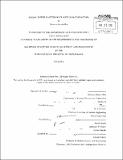Radial power flattening in sodium fast reactors
Author(s)
Krentz-Wee, Rebecca (Rebecca Elizabeth)
DownloadFull printable version (2.133Mb)
Other Contributors
Massachusetts Institute of Technology. Dept. of Nuclear Science and Engineering.
Advisor
M. J. Driscoll.
Terms of use
Metadata
Show full item recordAbstract
In order to improve a new design for a uranium startup sodium cooled fast reactor which was proposed at MIT, this thesis evaluated radial power flattening by varying the fuel volume fraction at a fixed U-235 enrichment of 18.5%. Of particular interest was how best to reduce the radial power peaking at the center of the reactor. Two cores were modeled: one with a uniform fuel volume fraction of 37% and one with fuel volume fractions which increased with the core radius. The ERANOS code was used to determine the power density, reactivity, and material values at the beginning and end of life. The varied fuel was shown to have a flatter radial power profile, but slightly lower reactivity and more mass. The power in each cell was normalized with respect to the average power; the peak power ratio in the uniform fuel volume core was 1.59, while the peak power ratio in the varied fuel volume core was 1.16, a significant improvement. The reactivity at beginning of life dropped from 12573.9 pcm to 11734.0 pcm, and stayed about 500pcm lower over the cycle, which is not a very large amount. The total mass of the heavy metals increased from the uniform core to the varied core by less than 0.9% and the mass of U-235 by 1.2%, so the varied fuel does not significantly impact the overall fuel cycle cost.
Description
Thesis (S.B.)--Massachusetts Institute of Technology, Dept. of Nuclear Science and Engineering, 2012. "June 2012." Cataloged from PDF version of thesis. Includes bibliographical references (p. 13).
Date issued
2012Department
Massachusetts Institute of Technology. Department of Nuclear Science and EngineeringPublisher
Massachusetts Institute of Technology
Keywords
Nuclear Science and Engineering.